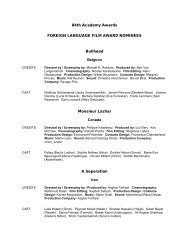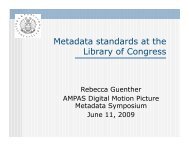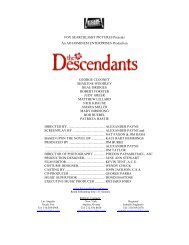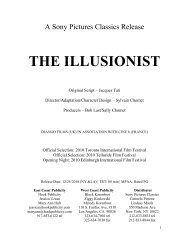Download Report - Academy of Motion Picture Arts and Sciences
Download Report - Academy of Motion Picture Arts and Sciences
Download Report - Academy of Motion Picture Arts and Sciences
You also want an ePaper? Increase the reach of your titles
YUMPU automatically turns print PDFs into web optimized ePapers that Google loves.
<strong>of</strong> energy radiated by tungsten in the region between<br />
600 <strong>and</strong> 700 mp.<br />
The reflecting power values <strong>of</strong> colors, as measured<br />
on a specified photographic material <strong>and</strong> with a<br />
definite quality <strong>of</strong> illumination, should be <strong>of</strong> great<br />
value in motion picture work. These values show<br />
definitely at what point on the tonal scale the color<br />
in question will be rendered. In the past a great<br />
deal <strong>of</strong> confusion has been caused by the fact that<br />
the photographic process did not render colored objects<br />
at the same point on the tonal scale as that at<br />
which they are seen by the eye, <strong>and</strong> it was necessary<br />
for the photographic technician to learn by experience<br />
just how a given color would be rendered.<br />
The advent <strong>of</strong> Panchromatic film <strong>and</strong> light sources<br />
relatively rich in long-wave radiation obviates this<br />
difficulty to a great extent since a fairly close approximation<br />
to orthochromatic rendering is obtained.<br />
Carefully determined photographic reflecting power<br />
values, however, for the colored objects to be used<br />
in a set should be very useful. It is well known<br />
that it is difficult for the eye to estimate the correct<br />
tone value <strong>of</strong> color under all conditions, especially<br />
in the presence <strong>of</strong> contrasting juxtaposed colors. Although<br />
the photographic technique used may give<br />
orthochromatic rendering, it is quite possible that<br />
the observer in judging the scene may be somewhat<br />
misled as to the point on the tone scale where certain<br />
colors will be rendered. If photographic reflection<br />
factors have been measured <strong>and</strong> are available,<br />
it is possible to adjust the tonal composition <strong>of</strong><br />
the set definitely <strong>and</strong> thus assure the desired result.<br />
It should be remembered, however, that photographic<br />
reflection {actor depends not only upon the<br />
colored object but also upon the quality <strong>of</strong> the illumination<br />
<strong>and</strong> the spectral sensitivity <strong>of</strong> the photographic<br />
material. While it is probably impracticable<br />
to measure the photographic reflection factor<br />
<strong>of</strong> every object used in a set, it does seem entirely<br />
feasible to st<strong>and</strong>ardize, to a certain extent, the use<br />
<strong>of</strong> color in set decoration. In any large studio, it<br />
should be possible to establish a certain number <strong>of</strong><br />
st<strong>and</strong>ard colors (such, {or instance, as wall paints)<br />
<strong>and</strong> to predetermine their photographic reflection<br />
factors. These reflection factors at once establish<br />
the positions <strong>of</strong> the colors on the gray scale in terms<br />
<strong>of</strong> which they must be reproduced. The end members<br />
<strong>of</strong> the gray scale are, o{ course, black <strong>and</strong> white<br />
with intermediate gray between. Practically, the<br />
blackest black available reflects from 2 to 4 per cent,<br />
while the whitest white reflects {rom 85 to 90 per<br />
cent. In establishing the gray scale, however, it<br />
should embrace the entire theoretical limits extending<br />
from 0 to 100 per cent. This gives a scale from<br />
0 to 100 <strong>and</strong> the position <strong>of</strong> any object can be 1ocated<br />
on the scale directly by its reflection {actor.<br />
It should be remembered that the visual sensation<br />
produced is proportional to the logarithm <strong>of</strong> the<br />
stimulus <strong>and</strong> not to the stimulus itself. This means<br />
that il we wish to establish a gray scale having uniform<br />
sensation steps, the increment from step to<br />
step must be in geometrical progression rather than<br />
arithmetical. For instance, a brightness scale <strong>of</strong> 1,<br />
t 38l<br />
2, 4, B, 16, etc., units gives a series <strong>of</strong> equal sensation<br />
steps, while the gray tone scale mentioned above<br />
as defined in terms <strong>of</strong> reflection factor, extending<br />
from 0 to 100 is entirely satisfactory <strong>and</strong> <strong>of</strong> practical<br />
utility. This logarithmic characteristic <strong>of</strong> our<br />
visual response should not be forgotten in applying<br />
the results to studio problems.<br />
DISCUSSION ON<br />
MR. JONES' PAPER<br />
Mn. Vorcr: We are greatly indebted to Mr.<br />
Loyd A. Jones for the paper he has given, <strong>and</strong> we<br />
'wanr to express a debt o{ gratitude to the Eastman<br />
Kodak Company, the General Electric Co., <strong>and</strong> all<br />
the other great corporations that have so generously<br />
sent their famous engineers <strong>and</strong> scientists out here to<br />
the coast. Mr. Jones is Past President <strong>of</strong> the Society<br />
<strong>of</strong> <strong>Motion</strong> <strong>Picture</strong> Engineers, which Society<br />
has contributed so largely to the scientific results<br />
that have been obtained in the industry. About a<br />
year ago I had the pleasure <strong>of</strong> entertaining Mr.<br />
Jones <strong>and</strong> saw a great deal <strong>of</strong> him out at the studio.<br />
When he talked to rne on various subjects like he<br />
has talked to you he would end by saying: "It's all<br />
very simple," <strong>and</strong> I said: "No, I don't see how<br />
simple it is-now will you please say it all over<br />
again so I can underst<strong>and</strong>," <strong>and</strong> then he would back<br />
.rp <strong>and</strong> tell it to me in what he called A, B, C,<br />
<strong>and</strong> I was then able to get about 10 per cent <strong>of</strong> it<br />
<strong>and</strong> then he told me in still simpler A, B, C, <strong>and</strong><br />
then I would get a little more. So, ladies <strong>and</strong> gentlemen,<br />
do not be frightened by Mr. Jones' mysterious<br />
words <strong>and</strong> curves, for he can tell it so even<br />
I can underst<strong>and</strong>, <strong>and</strong> will, I know, be pleased to<br />
answer any questions.<br />
Mn. Nrcror-eus: I am afraid Mr. Jones <strong>and</strong><br />
myself cannot get into an argument because I agree<br />
with him. I don't know in what way I can elaborate<br />
on his talk as he {ully ccvers the subject.<br />
I enter this discussion as a sort <strong>of</strong> a sympathetic<br />
representative <strong>of</strong> our cameramen'<br />
This discussion tonight should be very fruitful<br />
<strong>and</strong> I hope it will result in studio color technique<br />
going to one color or monotone.<br />
The discussion <strong>of</strong> color for sets has gone on at<br />
studios for years <strong>and</strong> one can see the reason for not<br />
mixing colors when as Mr. Jones has just said,<br />
there are about one hundred <strong>and</strong> fifty thous<strong>and</strong><br />
different shades <strong>of</strong> color. Imagine a set painted in<br />
difierent shades <strong>of</strong> different colors, such as many<br />
sets are painted. Who could tell just how the different<br />
tones will photograph ? This is <strong>of</strong> ten responsible<br />
for bad photography <strong>and</strong> wh5r do this when any<br />
one color can be split into eight shades with white<br />
on one end <strong>and</strong> black on the other. This I have<br />
called monotone <strong>and</strong> is now the vogue at most<br />
studios.<br />
I was very giad to hear Mr. Max Factor. He<br />
was very kind to come here <strong>and</strong> talk about make-up<br />
<strong>and</strong> that we will have monotone make-up. There<br />
is no reason why there should be eight colors on
















